Native Plant Road Trip to Woodway

Horses and live oak along Tin Top Road.
All photos by Steven Chamblee.
Small Things (and Cenizo)
Today was, or should I say, is amazing. The wonder of it all continues to astound, confound, thrill, and chill me. Each new day brings the opportunity for us to succeed, to make it to the Big Time. After 50 years, it is finally sinking into my hard head that the small roads, small towns, and small things that we hope will lead us to the Big Time actually are the Big Time. Like today….
Slept in a bit, took some time to rub my little dog’s belly real good, and spent a few minutes communing with the chickens after I let them out to free-range. (Yes, there are hazards to free-ranging my chickens, but the alternatives all seem to equate to “poultry prison,” and I sure didn’t move all the way out here for that.) Made up my coffee with honey from a beekeeper friend, fried up a few eggs that were just laid this morning, and topped them off with salsa made from tomatoes and chilies I picked 15 minutes before. You can’t get all that in the fanciest restaurant in New York City!
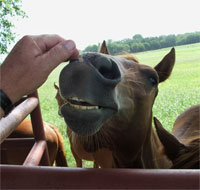
Nuzzle from Mother Nature
Hit the road feeling good, and had my sights set on the Carleen Bright Arboretum, a lovely little horticultural haven in Woodway, a green hamlet snuggled up to the southwest side of Waco. As usual, I forgot all about the freeways and slid down Tin Top Road … always a good choice. Didn’t make it far before I pulled over to take photos of some horses and a huge post oak in the distance. I thought I had spooked the horses in the near pasture when they suddenly came over to visit me over the pipe fence. Nothing like a dozen friendly horses vying for your attention … shiny coats as smooth as satin; dark eyes as big as silver dollars. If you pay close attention, you may notice how their supple nostrils can convey, like nimble fingers, an amazing array of emotions and tenderness of spirit. Interesting how Mother Nature’s creatures are all capable of gentle touch, even the unlikely ones; elephants, alligators, whales, and lions come to mind.
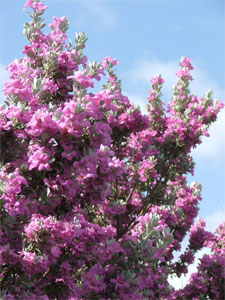
Cenizo (Leucophyllum frutescens)
Half a mile south of Tin Top, Texas, I had to make my second stop. The cenizo was blooming like crazy, so of course I had to take photos. (I already have dozens of pictures of it in bloom … but this is about today.) Cenizo (Leucophyllum frutescens) is a great native Texas shrub that is often called Texas sage (it’s not a sage) or Texas ranger (it’s not a lawman or baseball player). Some folks call it barometer bush because it flowers after rainfall, but, at least to me, that name sounds rather ignoble for a plant that can withstand anything but wet feet. Prized for its beautiful silver-gray foliage and toughness, cenizo has been planted far outside its native ranges in the Southwest, becoming a mainstream plant for water-wise, native Texas, and summer-blooming gardens. Of course, as with most plants, the blossoms are the main attraction to most gardeners. Colors of the inch-long, bell-shaped flowers can vary in the wild, from dark lavender to purplish-pink to pink to white. The profusion of blooms creates a spectacular scene, often literally smothering the plant under a blanket of blossoms. After a week or so, the flowers begin to drop off, but cenizo can repeat this performance several times between late May and late September … though one can never quite guess when. Perhaps the most amazing thing about cenizo is the plant’s ability to go from completely vegetative (not a flower bud showing anywhere) to covered in blooms in three to four days. I can’t think of another plant that can pull off this trick, not even other “scrophs” (members of the plant family, Scrophulariaceae), which include snapdragon, Indian paintbrush, and foxglove.
Granbury, Glen Rose, Walnut Springs … then a left on Highway 6 just south of Meridian. Just past the cliffs, there’s a little garden on the left where I drop an issue of GARDENS Magazine in the mailbox every once in a while. Belted cows, grapevines loaded with fruit, Illinois bundleflower, ironweed, and finally, the Lake Waco bridge. I’m not sure if it was intentionally designed to gently rock your truck when crossing it, but I felt like a baby in a bassinette. I walked into the Bright Arboretum auditorium all warm and fuzzy, to be greeted by the friendliest folks in Texas.
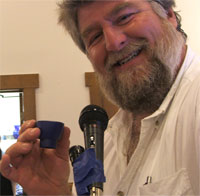
Steven with improvised mike stand
The crowd was a good mix of John Q. Public, Master Gardeners, and MG interns. We couldn’t find the microphone stand, but we did find a watering wand and some tape, so we made do in true Southern style … I loved it! When we got settled in, I couldn’t pass up an opportunity to publicly gig ag agent Shane McClellan about the interesting method used to save paper on the handout. Well, I forgot that when two or more Tarleton Texans are gathered together, strange things can happen … and sure enough, they did. Four minutes into my presentation, I realized I had sent them the wrong handout to print. Shane was tacitly polite while I awkwardly consumed my heapin’ helpin’ of humble pie in front of everyone … but I think I saw a little smirk of deep satisfaction cross his face.
The presentation went well, the snacks were superb, the folks seemed happy, and we eventually found the mike stand. Outside, the gardens looked great, but more importantly, testified to the commitment and spirit of the local community.
The Carleen Bright Arboretum is a collection of 19 gardens strewn over 14 acres. You’d never guess this beautiful oasis was once a city dump (just like the Japanese Garden in Fort Worth). From the Gazebo Garden to the Butterfly Garden to the Crape Myrtle Walk, all of the plants used are native or locally adapted to the Waco area, so that visitors can confidently use the Arboretum as a resource for their home plant selections. The Texas Superstars bed is a beautiful display of tough-as-nails color plants. Among the many trees in the Arboretum is a collection of native Texas oaks. My personal favorite aspect to the plantings is one of the most impressive cactus/yucca/agave collections I’ve seen in the Lone Star State.
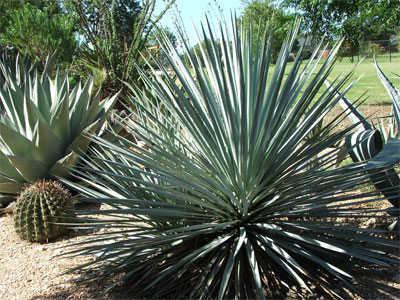
Cactus, yucca and agave, Bright Arboretum
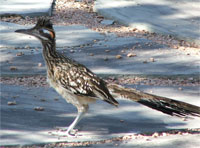
Roadrunner
The Arboretum also reflects the moods and history of the people who built it: the Homeland Patriots Garden honors police and firefighters, Sarah’s Place lovingly remembers a lost child, and the Meditation Garden is a sanctuary for those seeking peace. The Nature Trail is home to an amazing array of wildlife, including deer, fox, and a host of songbirds, most notably cardinals. The resident roadrunner appears faithfully each time I visit, tantalizing me to follow her to some secret place in the garden — which remains a secret, because there is absolutely no way to keep up with a roadrunner!
Like our own lives, the arboretum came together a little at a time, as time, money, and opportunity would allow. I can’t help but think of Will Rogers’ great quote: “Most people don’t recognize opportunity when it comes knocking because it shows up dressed as work.” In my 30-plus years knocking around horticulture, I’ve seen gargantuan gardens, dazzling displays, and stellar specimens — great stuff, without a doubt. But you won’t find a lot of that razzle-dazzle here because it doesn’t belong here. This garden isn’t Dolly Parton; it’s more like Kelly Clarkson. No Prada pretensions, no high-heeled hype. This is a place with a blue jean spirit, and you feel right at home from the minute you enter the gate.
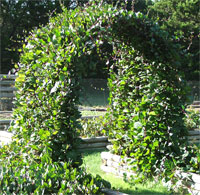
Ila Jean’s Malabar spinach arch
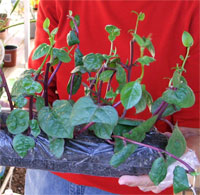
Pillow propagation
After my visit, I was wooed to the home of Ila Jean and Jon Caruthers. Truth be told, it didn’t take much … Ila Jean said she had a hard-working husband, a nice dog, and the finest Malabar spinach arch in McLennan County. Turns out, she was modest on all accounts. Jon has a number of talents, including woodworking, antique tractor restoration, and driving in the Great Race, where he drove a 1935 Chrysler Airflow against a field of other classics, including a 1927 Hispano Suiza worth roughly half a million dollars. The dog, Scarlett, is an energetic ball of fur that could charm the socks off an Eskimo. Now, about that Malabar spinach arch … I’d say it’s easily the best one in Texas. Ila Jean also toured me around the garden, bragged on her compost bins, and showed me the plants she’s growing using pillow propagation.
It was almost dark by the time I hit the road for Weatherford, and the drive home gave me time to ponder the gifts of the day. Great people, great gardens, great roads … great stories … hmmm, I do believe, indeed, that I’ve hit the Big Time.
Peace & Love,
Steven
About the author: Steven Chamblee is the chief horticulturist for Chandor Gardens in Weatherford and a regular contributor to Neil Sperry’s GARDENS magazine and e-gardens newsletter. Steven adds these notes:
Come out to Chandor Gardens and see us sometime. Just take I-20 west to exit 409, hang a right, go 2.1 miles and hang a left on Lee Avenue. Head straight 12 blocks and you’re driving in the gates. Call 817-361-1700 to let us know you’re coming, and we’ll light the incense and show you around. You can always go to www.chandorgardens.com for a picture tour and more information.
I can always use another road trip! Let me know if you’d like me to come out and speak to your group sometime. I’m low-maintenance, flexible, and you know I like to go just about anywhere. No city too big; no town to small. Just send me an e-mail at schamblee@weatherfordtx.gov and we’ll work something out.

